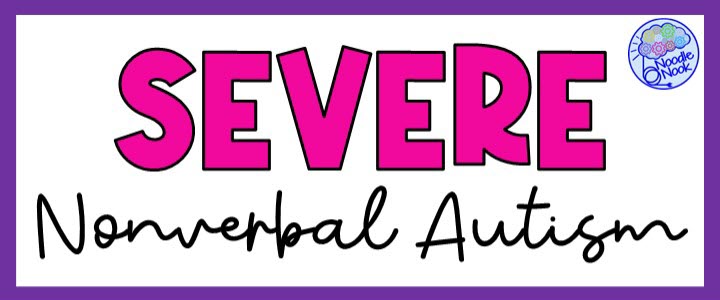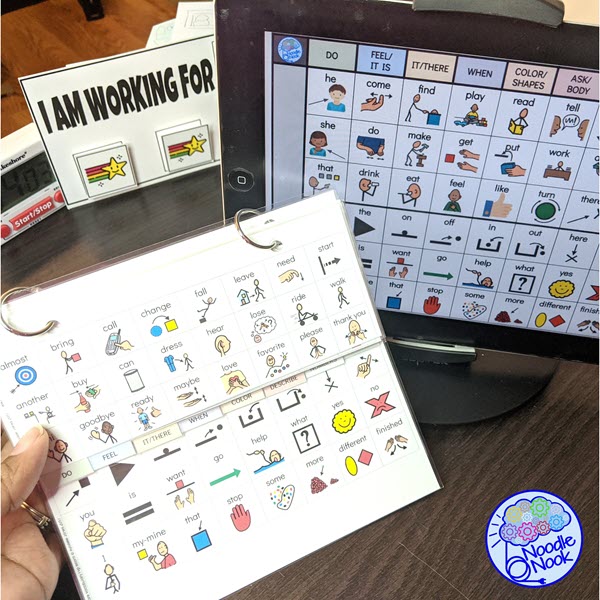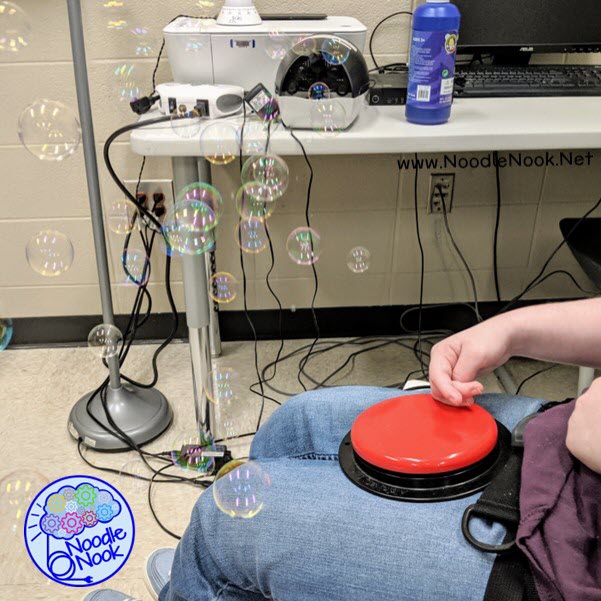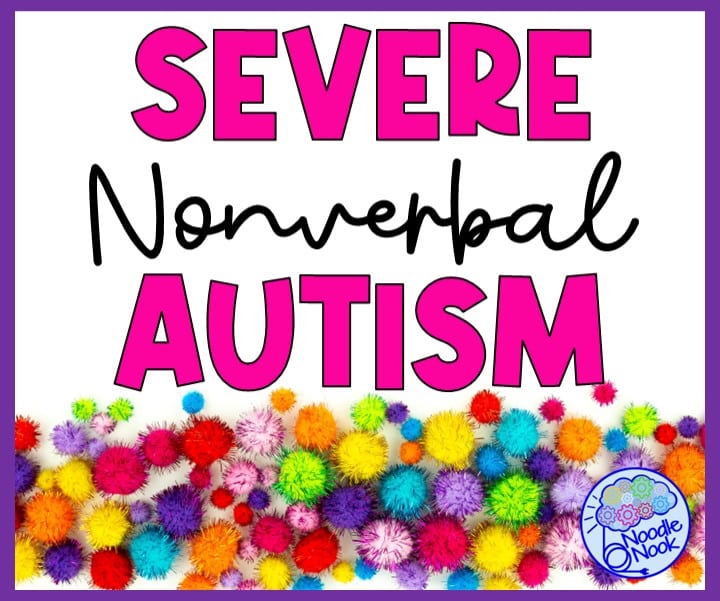Children with autism aren’t monolithic. There are many differences in sensory processing, social skills, communication, and academic skills. In other words, there is no one type of autistic person, even in cases of severe autism. If you’re a teacher, there are some ideas you should understand as you work with autistic children. We also have 9 strategies for effectively working with students with severe nonverbal autism.
What is Severe Nonverbal Autism?
Severe nonverbal autism refers to a form of autism spectrum disorder (ASD). It’s characterized by significant delays in language development and verbal communication. That includes impairments in the use of nonverbal communication such as gestures, facial expressions, and eye contact. Typically, severe nonverbal autism includes sensory processing issues, repetitive behaviors or interests, and rigidity with changes.
Children with severe nonverbal autism struggle with expressing themselves, processing verbal information, and understanding social cues. This leads to difficulties in social interactions and relationships which means it can limit connections with others. But just because these individuals struggle with verbal communication, it doesn’t mean they cannot communicate. It doesn’t mean they don’t have anything to say.
It’s important to remember students with severe nonverbal autism are people with thoughts, wants, needs, and opinions. They have lots of strengths. That often includes strong skills in areas like memory, pattern recognition, and repetitive behaviors. With the right support and early interventions, individuals with severe nonverbal autism can communicate with others.
How Common is Severe Nonverbal Autism?
Severe nonverbal autism, which includes significant limitations with communication and social interaction as well as limited verbal skills. Although the exact prevalence of severe nonverbal autism is unknown, studies suggest that it affects around 15-20% of individuals with an autism spectrum disorder.
Understanding severe nonverbal autism is crucial for educators, parents, and healthcare professionals. It helps them tailor appropriate support and interventions. Although severe nonverbal autism is not as common as other forms of ASD, meeting the needs of these children can be more difficult.
What Challenges Face Students with Severe Nonverbal Autism
Students with severe nonverbal autism face unique challenges in the classroom that require special attention and support from teachers. One of the biggest challenges is communication. These students may struggle with expressing their thoughts, needs, and emotions verbally. This can lead to frustration, misunderstandings, and misbehavior. After all, behavior is a form of communication. When behaviors turn negative, like with aggressive behavior, it makes it difficult for students to participate in class and build relationships with their peers or interact in the general population.
Also, students with severe nonverbal autism have difficulty understanding social cues and social interactions. That includes reading social cues, having trouble with eye contact, and engaging in repetitive behaviors. These challenges impact learning.
What are Characteristics of Severe Nonverbal Autism
Severe nonverbal autism is a subtype of ASD characterized by significant difficulties with social communication and social interaction. It also includes repetitive behaviors and restrictive interests. Unlike many individuals with autism, individuals with severe nonverbal autism have limited or no functional speech. They may also have trouble using gestures or other forms of nonverbal communication, such as eye contact or facial expressions, to convey their thoughts and emotions.
They may experience significant sensory sensitivities and have difficulty with motor coordination. This can affect their ability to participate in physical activities or daily living tasks. It’s important to note that the severity of symptoms and their impact can vary greatly from person to person, even within the subgroup of severe nonverbal autism.
An autism diagnosis is not always accompanied by a low IQ. In fact, students with higher IQs can also have a lack of speech. Symptoms of autism don’t include limits to mental capacity or academic ability. In other words, high-functioning autism and lower-functioning autism are not coordinated with academic aptitude.
Communication Challenges with Severe Nonverbal Autism
Students with severe nonverbal autism often face significant challenges when it comes to communication. As the name suggests, this form of autism involves difficulty in using verbal language, which can make it difficult for students to express themselves and connect with others. This can result in frustration, misunderstandings, and limited opportunities for social interaction. For some autistic individuals, their language skills continue to be limited well into adulthood. This includes a speech delay despite early interventions with a speech therapist or a speech-language pathologist (SLP).
Many students with severe nonverbal autism rely on alternative forms of communication. This can be with gestures, facial expressions, or written language. These may make it easier to relay needs, but is not a robust communication system. For a non-verbal autistic child to communicate effectively, they need a more reliable and robust system. That usually comes in the form of augmentative or alternative communication (AAC) systems. That can be with a voice output device (VOD). Depending on a person’s ability, they may use American Sign Language (ASL).
All of these systems provide a way to communicate in everyday life with people in their family members or caregivers. There are many different ways to interact with others despite their severe language delays. From hand gestures to a picture exchange communication system (PECS), the most important thing here is that nonverbal children can meaningfully interact in their daily life, just like neurotypical people.
As a teacher, it’s critical to support these forms of communication in the classroom as well as to provide appropriate accommodations to help these students develop a response mode.
Sensory Needs and Their Effect on Learning
Individuals with severe nonverbal autism usually have specific sensory needs. For the most part, sensory overload is most common. This means a student feels bombarded with too much sensory information at once. This causes distress, confusion, and difficulty in processing. In a classroom setting, this can lead to disruptions in learning as the student struggles to filter out relevant information and focus on the task at hand. Sensory overload can also result in behavioral outbursts, as the student becomes overwhelmed and struggles to cope with their environment.
Alternatively, some students with severe nonverbal autism may crave more sensory input or specific types of sensory input. Knowing the exact sensory needs of individuals with ASD can help you provide them with the right supports. That could include heavy work, weighted blankets, fidgets, chewing tools, or even mobile seating like yoga ball chairs.
To minimize the effects of sensory overload, it is important to create a classroom environment that is conducive to learning. It’s also important to understand the unique sensory needs of each student with severe nonverbal autism. This includes adapting the classroom design and setting up routines and procedures, using sensory aids and tools, and encouraging breaks when necessary.
Strategies for Students with Severe Nonverbal Autism
Supporting students with severe nonverbal autism in the classroom requires an understanding of their unique challenges and characteristics.
Here are some strategies that can help:
- Create a predictable and structured environment: Having a routine and clear expectations for students with severe nonverbal autism. This can reduce anxiety and provide a sense of stability.
- Use visual aids: Visual aids like visual schedules, visual cues, and visual prompts can be very helpful for students with nonverbal autism who struggle with verbal communication.
- Address sensory needs: Over-stimulation or under-stimulation can negatively impact learning for students with severe nonverbal autism. Implementing sensory-friendly modifications, such as adjustable lighting or noise-canceling headphones, can help regulate their sensory experience.
- Encourage alternative forms of communication: For students with severe nonverbal autism, alternative forms of communication such as sign language, picture exchange, or AAC use can help them effectively express their needs and ideas. Encourage communication, even through single words or body language.
- Collaborate with related service providers: Working with related service providers such as speech therapists, occupational therapists, and behavior analysts can provide additional support and strategies to enhance the student’s learning experience.
- Visual supports: Incorporating visual aids, such as pictures, schedules, and graphic organizers, can help students with severe nonverbal autism understand and participate in class activities. These supports can also reduce anxiety and increase independence.
- Sensory diet: Allowing students with severe nonverbal autism to take sensory breaks can help regulate their sensory processing and reduce stress. This can be as simple as taking a walk outside or using sensory toys and tools in the classroom. Target tools that support a student’s sensory issues.
- Use of technology: Utilizing technology, such as assistive communication devices and educational apps, can help students with severe nonverbal autism express themselves and participate in class activities.
- Building relationships and creating a safe environment: Building positive relationships with students with severe nonverbal autism and creating a safe and supportive classroom environment can have a significant impact on their academic and social success. This includes understanding their individual needs and providing accommodations, such as individualized seating arrangements, to meet those needs.
Implementing these strategies can help create an inclusive and supportive learning environment for students with severe nonverbal autism and promote their academic and personal growth.
Importance of Inclusion, Expectations, and Interventions
The inclusion of students with severe nonverbal autism in the general education setting is crucial for their overall development and success. It is important for teachers to have high expectations for these students and believe in their abilities, despite their communication and behavior challenges. Early intervention is also key in addressing the unique needs of these students and providing them with the necessary support and resources to succeed. Working on the development of speech for young children with severe nonverbal autism is the best way to develop those first words and work towards language skills. As the parent of a child showing severe symptoms of autism, you may wonder if your child will ever talk. While not all individuals with non-verbal autism develop verbal language, nonverbal autistic people all have the capacity to communicate in some way.
As a teacher, implementing strategies such as visual supports, sensory breaks, the use of technology, and building relationships can create a positive and inclusive learning environment for these students. Work with parents to promote inclusion, set high expectations, and provide early interventions.
Continued Learning for Teachers
Special education teachers need to continue learning about severe nonverbal autism and advocating for the needs of these students. As an educator, you play a critical role in helping these students reach their full potential. By staying up to date on recent study results and best practices, you can provide the best possible support for your students.
Also, by advocating for their needs, you can help to create a more inclusive and understanding environment for all students. Keep in mind that every student is unique, and it is important to approach each student with an open mind and a willingness to learn. Your dedication and commitment to these students will make a difference in their lives and their future success.
RECAP: Severe Nonverbal Autism
Understanding severe nonverbal autism is crucial for teachers, parents, and other professionals who work with children with this condition. This includes being aware of the unique challenges and difficulties that students with severe nonverbal autism face in the classroom. That may be with things like communication difficulties, sensory overload, and difficulty building relationships.
By implementing effective strategies, such as the use of visual supports, sensory breaks, technology, and creating a safe and inclusive environment, educators can help students with severe nonverbal autism thrive in the classroom. It is also important for educators to continue learning about this condition and advocating for students with severe nonverbal autism to receive the necessary support and resources they need. With proper support and understanding, students with severe nonverbal autism can reach get an educational benefit in the classroom and make progress on their individual goals.
Article Citation: [cite]




